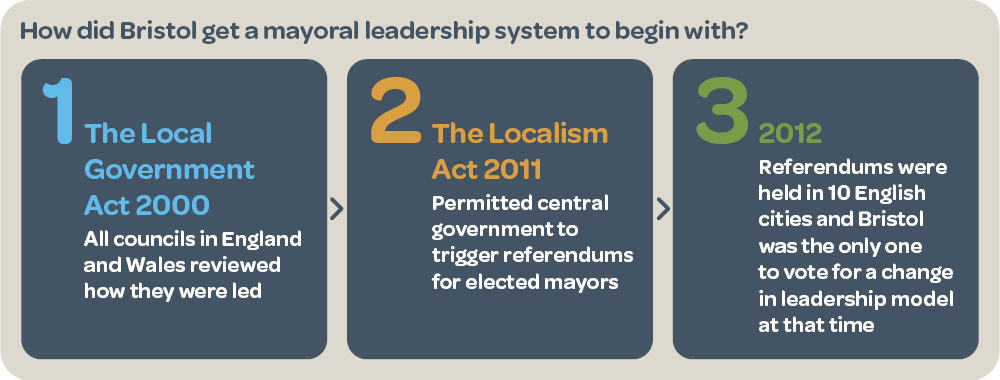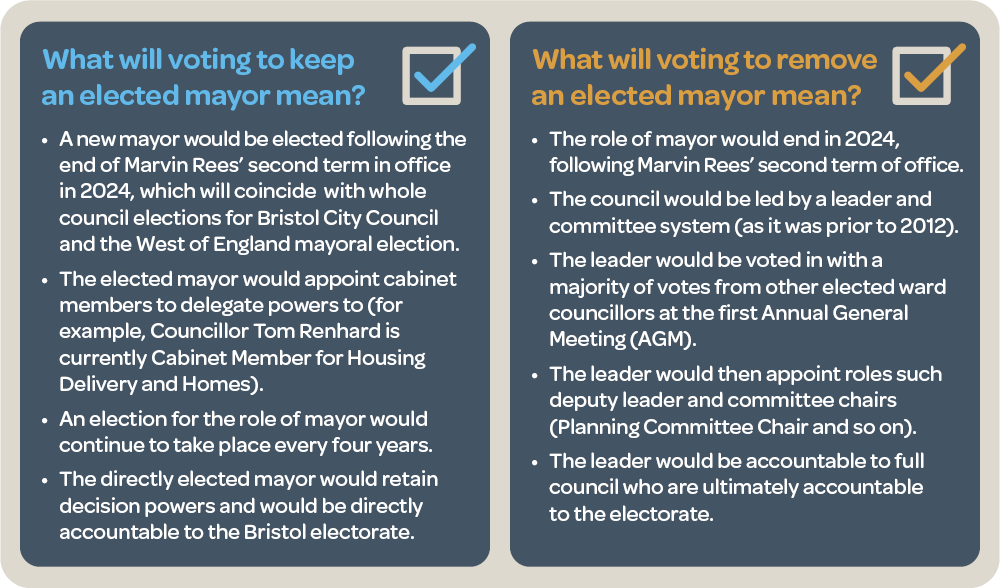Comment
What does the Bristol Mayoral referendum mean for planning and investment in the city?
In May, Bristol’s residents will be asked to vote on whether they want to retain the role of the city’s mayor or whether they want to replace it with a committee system. Strategic Communications Associate Director, Andrea Kellegher and Senior Consultant, Emily Bell set the scene for what will be an important decision for Bristol’s future.
Before we consider the impact the decision could have on planning and investment in the city, it’s first important to go back to the beginning.


Have things changed for the leadership of the city since voting in the mayoral system in 2012?
Beyond the political changes the role of mayor in Bristol has changed since its inception 10 years ago. In 2017, a new role of West of England metro mayor was created to represent the West of England Combined Authority (including Bristol, South Gloucestershire and Bath & North East Somerset) following the devolution deal which saw the Combined Authority gain powers over transport, skills and strategic planning across the region. The metro mayor’s (currently Labour’s Dan Norris) responsibility covers the West of England, whilst the Bristol mayor focuses on the city itself.
The extra layers of leadership for the city and the region more widely are for some a confusing amalgamation of councillors, cabinets, leaders and task forces, and it can be difficult to make sense of who has what role and responsibility. It can also lead to conflicts in agenda – particularly at times where the metro mayor’s political position differs from the city mayor (as was the case with Conservative metro mayor Tim Bowels and Labour city mayor Marvin Rees between 2017 – 2021). We are now in a period where the new metro mayor, Dan Norris, and Mayor Marvin Rees are politically aligned, though perhaps it is too early to confirm whether this has had any tangible benefits in strategy and direction for the city.
Why is the referendum happening now?
It’s important to note that campaigns to change the leadership of an authority are not uncommon. In fact, it can come hand in hand with the opposition parties’ desire to hold their opponents to account. As both the Liberal Democrat and Conservative 2021 mayoral candidates made manifesto promises to ‘scrap the mayor’; this move was no surprise.
Politically the timing is important as the 2021 election resulted in Bristol City Council having no overall majority – with Labour and the Green Party on 24 seats each (the Conservatives retained 14 seats and Liberal Democrats retained 8). Whilst Labour has a minority, the election of a Labour mayor resulted in a Labour led council with a Labour cabinet. However, Labour does not have a majority on either of the planning committees, with membership reflecting the political make-up of the council (with Conservative and Green committee chairs). A split council like this with a leader and committee system could have resulted in a more unstable administration.
What could the decision mean for planning and investment in the city?
When it comes to investment, the role of mayor can provide a city with more visibility on a national and international platform. It can set an agenda for a city, as we saw under George Ferguson in 2012 when Bristol became the ‘UK’s Green Capital’. It can also provide a strategic role to attract investment – as we’ve seen in Bristol with ‘Channel 4’ under Marvin Rees’ leadership along with the projection of his profile on an international platform following the toppling of the Colston Statue.
From a planning perspective, a mayor can set the strategic direction of the city. However, when it comes to planning application decisions, the mayor has relatively little power, as they do not sit on a planning committee.
What will the outcome be?
The yes and no campaigns are in full swing. To confuse matters, researchers at the University of Bristol have prepared a report which questions whether the committee approach was the right second option. This follows a similar line of thinking to some business leaders in the city, who consider whether a completely new leadership system would best fit the specific challenges and needs of Bristol.
At this stage, it’s too early to gain a real sense of local opinion. However, the turnout for the mayoral referendum in 2012 was just 24% (with 53% voting in favour of a directly elected mayor) and the average turnout for the three mayoral elections held to date is 38%. It’s therefore likely that very small numbers will determine the future leadership approach for the city.
If you want to learn more about the upcoming Bristol elections, get in touch with Emily Bell or Andrea Kellegher.
29 March 2022
You may also be interested in
News
17 March 2022
Turley helps Telereal Trillium get the green light for redevelopment of Flowers Hill, Brislington, Bristol
Telereal Trillium’s plans to redevelop the government buildings complex on Flowers Hill and create up to 160 new homes have been ...